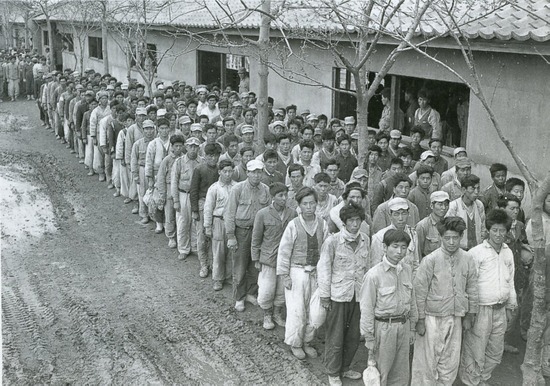National Defense Corps incident on:
[Wikipedia]
[Google]
[Amazon]

 The National Defense Corps Incident ( ko, 국민방위군 사건,
The National Defense Corps Incident ( ko, 국민방위군 사건,

 The National Defense Corps Incident ( ko, 국민방위군 사건,
The National Defense Corps Incident ( ko, 국민방위군 사건, Hanja
Hanja (Hangul: ; Hanja: , ), alternatively known as Hancha, are Chinese characters () used in the writing of Korean. Hanja was used as early as the Gojoseon period, the first ever Korean kingdom.
(, ) refers to Sino-Korean vocabulary, ...
: 國民防衛軍事件) was a death march
A death march is a forced march of prisoners of war or other captives or deportees in which individuals are left to die along the way. It is distinguished in this way from simple prisoner transport via foot march. Article 19 of the Geneva Conven ...
that occurred in the winter of 1951 during the Korean War
{{Infobox military conflict
, conflict = Korean War
, partof = the Cold War and the Korean conflict
, image = Korean War Montage 2.png
, image_size = 300px
, caption = Clockwise from top:{ ...
.
On 11 December 1950, South Korea issued an act establishing the National Defense Corps. South Korean citizens aged 17 to 40, excluding military, police and government officials, were drafted into the National Defense Corps.
The Syngman Rhee
Syngman Rhee (, ; 26 March 1875 – 19 July 1965) was a South Korean politician who served as the first president of South Korea from 1948 to 1960.
Rhee was also the first and last president of the Provisional Government of the Republic of Ko ...
government adopted officers from Great Korean Young Adults Association (대한청년단; 大韓靑年團), which was a pro-Rhee Syngman group, into the Corps.
Immediately, 406,000 drafted citizens were deployed in 49 training units, then National Defense Corps soldiers were ordered to march southward on the Korean peninsula
Korea ( ko, 한국, or , ) is a peninsular region in East Asia. Since 1945, it has been divided at or near the 38th parallel, with North Korea (Democratic People's Republic of Korea) comprising its northern half and South Korea (Republic ...
under the Chinese offensive. However, funds for food purchases were embezzled by the National Defense Corps Commander Kim Yun-geun (김윤근 金潤根; also spelled Kim Yoon-keun or Kim Yungun), son-in-law of Defence minister
A defence minister or minister of defence is a cabinet official position in charge of a ministry of defense, which regulates the armed forces in sovereign states. The role of a defence minister varies considerably from country to country; in s ...
Shin Sung-mo. Approximately 300,000 men were lost to death or desertion during the three-week, 300-mile "death march". By June 1951, when an investigating committee made known its findings, it was reported that some 50,000
to 90,000 soldiers starved to death or died of disease on the march and in the training camps.
On 30 April 1951, the National Assembly of South Korea
The National Assembly of the Republic of Korea, often shortened to the National Assembly in domestic English-language media, is the unicameral national legislature of South Korea. Elections to the National Assembly are held every four years ...
adopted a resolution on disbandment of the National Defense Corps. The National Assembly investigation showed that the commanding officers embezzled one billion won, and tens of millions of won was misappropriated to President Syngman Rhee
Syngman Rhee (, ; 26 March 1875 – 19 July 1965) was a South Korean politician who served as the first president of South Korea from 1948 to 1960.
Rhee was also the first and last president of the Provisional Government of the Republic of Ko ...
's political fund.
In May 1951, vice-president Yi Si-yeong
Seongjae Yi Si-yeong (Chosŏn'gŭl: 이시영; Hanja: 李始榮, December 3, 1868 – April 19, 1953) was a Korean politician, independence activist, educator and neo-Confucianist scholar. He was the first vice president of South Korea from ...
resigned. In June, it was reported that five billion won in funds for the National Defense Corps had been embezzled. On 12 August 1951, five commanding officers were executed as persons in charge of the incident.
See also
*December Massacres of 1950 in the Korean War The December massacres were a series of politically motivated executions carried out by the South Korean government following the recapture of Pyongyang by communist forces in the Korean War. The killings took place in South Korea, but mainly in and ...
*Truth and Reconciliation Commission (South Korea)
The Truth and Reconciliation Commission ( ko, 진실·화해를위한과거사정리위원회), established on December 1, 2005, is a South Korean governmental body responsible for investigating incidents in Korean history which occurred fro ...
References
{{DEFAULTSORT:National Defense Corps Incident War crimes in South Korea South Korean war crimes Military scandals Korean War crimes Political scandals Forced marches 1951 in South Korea